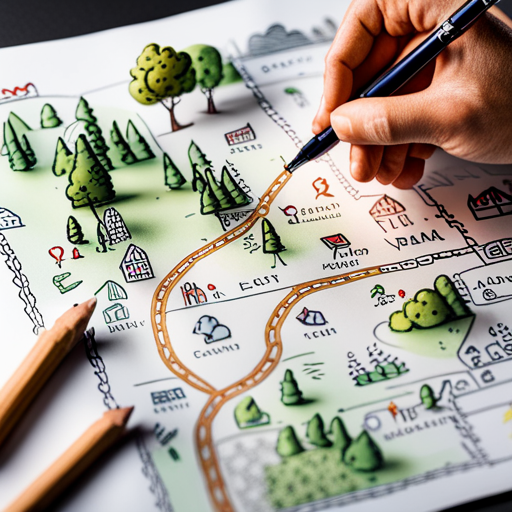As an Amazon Associate I earn from qualifying purchases.
Are you ready for anything life throws your way? It’s time to take control and prepare for the unexpected.
Crafting your bug-out plan is essential for achieving freedom and peace of mind. Assess your risks and needs, create a comprehensive emergency kit, and establish communication protocols.
Map out evacuation routes and set up a temporary shelter. With a well-thought-out plan, you’ll be ready to take on any challenge that comes your way.
Get started today and embrace the power of preparedness.
Key Takeaways
– Assess vulnerabilities in location, climate, and potential threats
– Create an emergency kit with essential supplies such as food, water, first aid, and communication tools
– Map out evacuation routes and identify transportation options
– Set up temporary shelter with sturdy materials and consider location for safety and access to resources
Assessing Your Risks and Needs

You’ll need to evaluate your specific risks and needs when it comes to preparing your bug-out plan. Freedom-loving individuals like yourself understand the importance of being prepared for the unexpected.
Start by identifying vulnerabilities in your current situation. Consider factors such as your location, climate, and potential threats in your area. Are you in a region prone to natural disasters like hurricanes or earthquakes? Are you living in an urban area with a higher risk of civil unrest? Assessing these risks will help you determine what resources and skills you need to prioritize in your bug-out plan.
Once you’ve identified your vulnerabilities, it’s time to develop contingency plans. Think about different scenarios that could disrupt your daily life and plan accordingly. If you live in an area prone to wildfires, for example, you may need to have a plan in place to evacuate quickly with important documents and supplies. If your concern is a prolonged power outage, you might want to invest in alternative energy sources or stock up on non-perishable food and water.
Remember, your bug-out plan should be tailored to your individual needs and circumstances. Regularly review and update it as necessary. By evaluating your risks and developing contingency plans, you can ensure that you’re prepared to face any unexpected challenges that come your way.
Stay vigilant, stay informed, and stay free.
Creating a Comprehensive Emergency Kit

Don’t forget to include essential items in your emergency kit. When it comes to preparing for the unexpected, having a comprehensive emergency kit is crucial. It’s not just about having emergency food and essential supplies, but also about being prepared for any situation that may arise. Your emergency kit should be tailored to your specific needs and risks, ensuring that you have everything you need to survive and thrive in a crisis.
Start by stocking up on emergency food that has a long shelf life and requires minimal preparation. Canned goods, granola bars, and freeze-dried meals are all great options. Don’t forget to include a can opener and utensils for eating. Water is also essential, so make sure to have enough for at least three days.
In addition to food and water, your emergency kit should include other essential supplies. A first aid kit, flashlight, batteries, and a portable radio are all must-haves. A multi-purpose tool, duct tape, and a whistle can also come in handy. Don’t forget to pack extra clothing, blankets, and personal hygiene items like toothpaste and toilet paper.
Establishing Communication Protocols

Establishing communication protocols is essential during an emergency. It helps ensure that you can stay connected with your loved ones and receive important updates. When chaos strikes, having a plan in place to establish emergency contacts and create a communication network is crucial for your safety and peace of mind.
Begin by identifying your emergency contacts, those who you trust and can rely on during an emergency. These contacts should be dependable individuals who will keep you informed and provide support when needed. Share your emergency contact information with them and make sure they have yours as well.
Next, create a communication network that includes multiple methods of communication. Don’t solely rely on one channel, as it may become overwhelmed or unavailable during an emergency. Utilize a combination of phone calls, text messages, social media, and even walkie-talkies to ensure you have various options for staying connected.
Additionally, consider establishing a meeting point with your loved ones in case you are separated during an emergency. This designated location will serve as a central gathering place where you can regroup and ensure everyone’s safety.
Mapping Out Evacuation Routes

Mapping out evacuation routes is a crucial step in ensuring your safety during an emergency. When disaster strikes, having a well-thought-out plan can make all the difference in the world. Here are four key reasons why you should take the time to map out your evacuation routes:
1. Freedom to choose: By mapping out multiple evacuation routes, you give yourself the freedom to choose the best option based on the situation. Whether it’s avoiding traffic, roadblocks, or hazardous areas, having alternatives ensures that you can make informed decisions.
2. Quick and efficient escape: Time is of the essence during an emergency. Having pre-planned evacuation routes allows you to escape quickly and efficiently, minimizing the risk to your safety.
3. Access to emergency transportation options: Mapping out evacuation routes also helps you identify emergency transportation options. This could include public transportation, designated shelters, or even alternative modes of transportation like bikes or boats.
4. Peace of mind: Knowing that you have well-defined evacuation routes gives you peace of mind. It allows you to focus on other aspects of emergency preparedness, knowing that you have a clear and safe path to follow if the need arises.
Setting Up a Temporary Shelter

When setting up a temporary shelter, make sure you have enough supplies to provide for your basic needs. Freedom-loving folks like yourself understand the importance of being prepared for any situation. So, let’s talk about the materials you’ll need for your temporary shelter and how to choose the perfect location.
First, let’s talk about shelter materials. You’ll want to have a sturdy tent or tarp that can withstand harsh weather conditions. Look for materials that are lightweight and easy to carry, but also durable enough to last. Don’t forget about sleeping bags or blankets to keep you warm during those chilly nights. And of course, don’t forget the essential tools like a hammer, nails, and a multitool.
Now, let’s discuss the shelter location. When choosing a spot, consider factors like safety, accessibility, and availability of resources. Look for a location that is hidden from view, but also easily accessible for you to come and go as needed. It should be close to a water source and have enough space for you and your supplies. Remember, the goal is to find a spot that provides both security and convenience.
Frequently Asked Questions
How Do I Ensure the Safety of My Pets During a Bug-Out Situation?
To ensure the safety of your pets during a bug-out situation, prioritize emergency pet care. Plan ahead by packing essential supplies, creating a designated pet carrier, and identifying pet-friendly shelters or accommodations.
What Should I Do if I Have Young Children or Elderly Family Members to Care for During an Emergency?
During an emergency, caring for vulnerable individuals is crucial. To ensure the safety of children and elderly in bug-out situations, have a plan in place, gather necessary supplies, and prioritize their needs above all else.
How Can I Protect Important Documents and Valuables During a Bug-Out Situation?
To protect documents and valuables during a bug-out situation, secure them in a waterproof and fireproof safe. Consider making digital copies of important documents and storing them on a portable hard drive or in the cloud for added security.
Are There Any Legal or Regulatory Considerations I Should Be Aware of When Preparing My Bug-Out Plan?
When preparing your bug-out plan, it’s important to consider any legal or regulatory considerations. Ensure that you comply with any laws or regulations that may affect your plan and prioritize your freedom.
What Steps Can I Take to Mentally Prepare Myself and My Family for the Stress and Uncertainty of a Bug-Out Situation?
To mentally prepare yourself and your family for the stress and uncertainty of a bug-out situation, focus on mental health support and communication strategies. These steps will help you maintain a sense of freedom and readiness.
Conclusion
In conclusion, preparing for the unexpected is crucial for your safety and well-being. By assessing your risks and needs, creating an emergency kit, and establishing communication protocols, you can be better equipped to handle any unforeseen circumstances.
Additionally, mapping out evacuation routes and setting up a temporary shelter are important steps in being prepared. These actions will help you and your loved ones stay safe during emergencies.
Remember to regularly update and practice your bug-out plan to ensure its effectiveness. This will ensure that you are well-prepared and ready to respond quickly when necessary.
With proper preparation, you can have peace of mind knowing that you are ready for whatever comes your way. Stay safe and be prepared!
As an Amazon Associate I earn from qualifying purchases.










